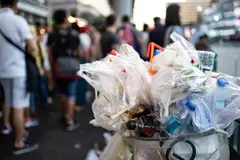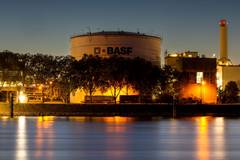Italian trash to Dutch treasure? Amsterdam to turn Rome’s imported waste into energy
19 Apr 2023 --- To solve Rome’s waste processing problem, the city has signed a deal with Amsterdam’s Waste and Energy Company (AEB) to export 900-1800 metric tons of baled waste to the Dutch capital weekly. AEB will process the waste in its incinerators to generate energy.
While AEB claims to provide a “grateful contribution,” reportedly, members of the Dutch parliament expressed their discomfort with the deal, as the Dutch ministry for infrastructure and waste management was not involved in the decision-making.
Additionally, David Bolscher, sector analyst of Industry, Transport and Logistics at ABN Amro, warns that the environmental benefit of Amsterdam importing waste for incineration depends on the composition of the trash and could cause ecological damage if the waste contains too much plastic.
“Most of the emissions from the incineration of Italian waste are created by the presence of plastic in waste. According to CE Delft, household waste in Italy consists of an average of 13% plastic. For a city like Rome, this will be slightly higher. This relatively small part leads to more than half of the greenhouse gasses when burned here in Amsterdam,” shares Bolscher.
“Nevertheless, incineration in Amsterdam instead of a landfill in Rome only makes sense once the share of plastic is above 39%. The total emissions from incineration of Italian waste can be reduced by more than two-thirds if plastic is separated from the waste and offered for recycling. This is not happening now because the AEB’s separation installation is already full.”
 According to AEB, processing waste in the Netherlands is more beneficial to the environment than landfill in Italy.Waste to energy
According to AEB, processing waste in the Netherlands is more beneficial to the environment than landfill in Italy.Waste to energy
AEB details that its incineration plant obtains a high energy yield from the waste and therefore from an environmental point of view, it is preferable to landfill.
“AEB has a permit to process 1.4 million tons of waste and convert them into heat and electricity. In the process, a set amount of nitrogen may be emitted. The waste from Rome falls within the processing capacity and therefore [AEB’s carbon] footprint is not increased,” AEB’s Esther Sloots tells PackagingInsights.
“AEB wants to run the plants as well as possible to generate heat and electricity. That includes using the capacity as fully as possible because otherwise, the plants run less efficiently, which is more expensive. Moreover, landfilling is still very common in many European countries. That is significantly worse for the environment than transporting and processing it in Amsterdam.”
Rome’s waste processing capacity was further diminished last year when a fire broke out at the city’s largest waste processing facility. According to reports, the new incinerator commissioned for the town will not be functional until 2026.
Waste treatment infrastructure
Sloots at AEB maintains that processing waste in the Netherlands is more beneficial to the environment than local landfill in Italy.
“The environmental impact of transporting waste is small, especially if the waste is transported by train. The climate gain is then still substantial. This is according to an external study conducted by CE Delft,” she says.
“AEB, like many other Dutch waste processors, has capacity to process waste from foreign customers. AEB processes this waste in our efficient waste incinerators and turns it into energy for households and businesses. The metals from incineration are recycled, the remaining bottom ash is used in infrastructural projects.” Bolscher at ABN Amro shares that the total emissions from incineration of Italian waste can be reduced by more than two-thirds if plastic is separated.
Bolscher at ABN Amro shares that the total emissions from incineration of Italian waste can be reduced by more than two-thirds if plastic is separated.
Vanya Veras, secretary general at Municipal Waste Europe, tells us that Italy’s waste management infrastructure lacks waste treatment facilities, especially bio-waste from a separate collection, treatment plants and a waste-to-energy plant.
“The evolution of separate waste collection must go hand in hand with the evolution of waste treatment capacity. And even after separately collecting 80% of the waste, no less than 25% remains (mixed waste plus the waste from sorting and recycling facilities) to be treated,” says Veras.
“It should be considered that Rome is a big city that produces more than half of the waste of the entire region in which it is located. It needs dedicated waste management planning and facilities, and that’s what it is trying to do.”
Bolscher cites the CE Delft study to highlight that every week, the 900 tons of waste from Rome contains 117 tons of plastic. “A separation plant can supply 82 tons of plastic for recycling here [in Amsterdam]. When recycled, another 80% is converted into new raw material. The plastic that remains is still burned in the ovens.”
“If the separation were to take place in Rome, less CO2 would also be emitted during the transport of the waste,” he continues.
 The problem in Rome is historically linked to the presence of a large landfill that accepted waste at a low price.Roman rubbish
The problem in Rome is historically linked to the presence of a large landfill that accepted waste at a low price.Roman rubbish
Moreover, Veras tells us the problem in Rome is historically linked to the presence of a large landfill that accepted waste at such a low price that any other waste management option was more expensive – “a real dumping.”
“For this reason, the city had not equipped itself with waste treatment infrastructure. In the last ten years, with the implementation of the waste legislation and the closure of the landfill, the city had to face the challenge of building waste treatment plants.”
Veras iterates that the transfer and treatment of Rome’s waste for incineration to the Amsterdam facility is temporary and will end as soon as Rome’s biowaste and residual waste treatment plans are ready to accept the waste.
Bolscher adds: “Rome expects to be able to commission its waste incineration plant from 2026. This would temporarily solve their waste problem. Substantial investments in separation installations are required to further reduce environmental damage. These separation installations increase the quality and supply of plastic waste.”
“More capacity of separation installations must be realized to limit the environmental damage of plastic. When waste is better separated, there is more and a better quality supply for recycling companies.”
By Radhika Sikaria












